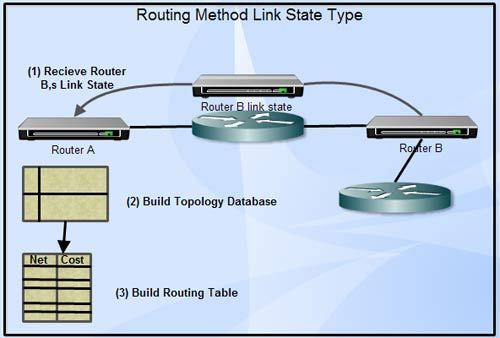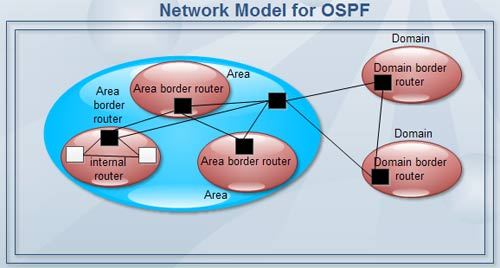These are OSPF, IS-IS (Intermediate System to Intermediate System Intra-Domain Routing Exchange Protocol).
Algorithm where each router in the network learns the network topology then creates a routing table based on this topology. Each router will send information of its links (Link-State) to its neighbor who will In turn propagate the information to its neighbors, etc. This occurs until all routers have built a topology of the network. Each router will then prune the topology, with itself as the root, choosing the least-cost-path to each router, then build a routing table based on the pruned topology.
In link-state protocols, there are no restrictions. in number of hope as in distance-vector protocols, and these are aimed at relatively large networks such as Internet backbones. The load on routers will be large however, since processing is complex.

OSPF (Open Shortest Path First)
OSPF (details in RFC1247) is a link-state type routing protocol developed for use in a large-scale network by eliminating the disadvantages of RIP. This is the only standardized inter-domain protocol for the Internet as of today, and offers the following features.
- Compatible with hierarchical topology for network
- Allows use of subnet mask of variable length
- Allows load distribution when two or more routes are available
- Supports authorization method for improved security.
In OSPF, each domain is divided into several areas. Detailed configuration of each area can be hidden from other areas. Therefore, routers that belong to the same area have the same network configuration information while routers belonging to other areas have different configuration information. Because one area is composed of subnets with serially assigned addresses, external intervention is not necessary to manage the route to reach each address in that area. It is only necessary to manage the route to that area as an integral route to a series of those addresses.

Network Model for OSPF
Routers can be classified into 3 types as shown below. One router may play two or more roles. Also, routing information exchanged between these routers is called LSP (Link State Packet).
- Domain Border Router This router exchanges route information with routers in other domains. Information thus obtained is included in an OSPF message and transferred to other routers in the same domain (domain to which domain border router belongs). This allows all routers in the same domain to know which domain border router can provide route information to a specific domain.
- Internal Router Internal router is a router having its links directly connected to a network within a specific area. That is, internal router does not have any direct links to a network in another area.
- Area Border Router This router belongs to two or more areas and notifies the backbone of the outline of its own configuration information so that this outline information can be transferred to other area boundary routers.
The backbone consists of those networks not contained in any area, their attached routers, and those routers that belong to multiple areas.
To recapitulate what has been described above, OSPF is an hierarchical routing composed of intra area routing, inter-area routing, inter-domain routing, and so on. This means that if a message needs to be sent from one area to another, this message will sequentially pass.
Source host –> internal router –> Area border router in the same area –> Domain border router in the same domain –>Destination domain border router –> Destination area border router –> –> –> Destination internal router –> Destination host.

 Dinesh Thakur holds an B.C.A, MCDBA, MCSD certifications. Dinesh authors the hugely popular
Dinesh Thakur holds an B.C.A, MCDBA, MCSD certifications. Dinesh authors the hugely popular